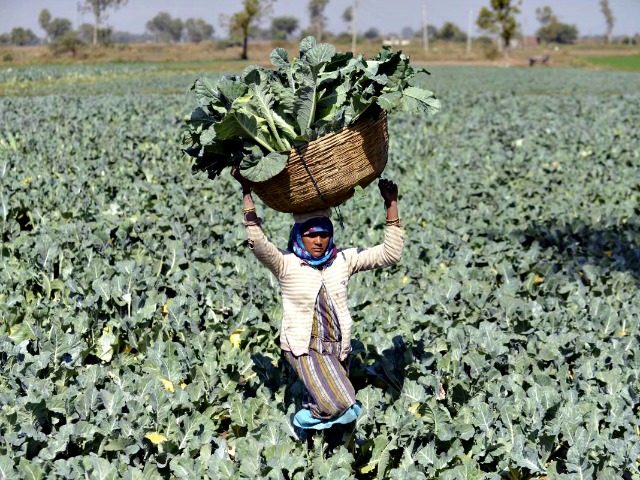Scientists writing in the journal Nature Climate Change are speculating that increased levels of carbon dioxide by way of climate change will cause crops to lack vital nutrients, thereby harming the health of millions of people around the world.
And people in the poorest parts of the world will be hardest hit, according to the article reported by the Guardian.
Citing a Nature Climate Change report from 2014, the Guardian said scientists reported that food crops could become less nutritious according to “expected” CO2 levels in 2050, specifically lacking current amounts protein, iron, and zinc.
The Guardian reported:
Now experts say such changes could mean that by the middle of the century about 175 million more people develop a zinc deficiency, while 122 million people who are not currently protein deficient could become so.
In addition, about 1.4 billion women of childbearing age and infants under five years old will be living in regions where there will be the highest risk of iron deficiency.
Among other problems, zinc deficiencies are linked to troubles with wound healing, infections and diarrhea; protein deficiencies are linked to stunted growth; and iron deficiencies are tied to complications in pregnancy and childbirth.
“This is another demonstration of how higher CO2 could affect global health that may not be as well recognized,” Dr. Matthew Smith, co-author of the study from the Harvard TH Chan School of Public Health, said in the Guardian article. “Continuing to keep up our vigilance around reducing CO2 emissions becomes all the more important because of this research.”
Smith and co-author Samuel Myers, also from Harvard, said they used a “host of sources” for their research project, including data from the United Nations to examine 225 food crops such as rice, maize, certain vegetables, roots, and fruit
“The team also took into account regional differences in the nutrient content of crops and how diet differs with age and sex within countries, using data collated by other researchers from surveys around the world,” the Guardian reported.
The Guardian admitted that the research is relevant “assuming CO2 levels continue to rise at the current rate.”
Of the 151 countries examined in the research, the authors concluded that North Africa, south and south-east Asia, the Middle East, and sub-Saharan Africa are likely to be some of the hardest hit regions.
In India, by 2050, some 50 million more people will be zinc deficient, and 38 million more protein deficient, according to the Guardian.
The article also notes researchers believe little impact will be felt in the United States, France, Australia and parts of South America.
The Guardian also reported the limitations of the study, including assumptions that diets will remain constant and that CO2 levels might spur plant growth.
But “Even if individuals were able to eat more of the plants to get the same nutrient intake, they might end up with other issues like obesity.”
Dr. Kai Zhu, assistant professor of environmental studies at the University of California at Santa Cruz, was not involved in the study but said in the Guardian article the study should serve as a warning.
“If no actions are taken, additional millions to billions of people will be nutrition deficient because of rising CO2, and the most vulnerable regions in the world will suffer the greatest impacts,” Zhu said. “Future public health policies have to take climate change into consideration.”
But according to an Institute of Energy Research (IER) report in May, U.S. greenhouse gas emissions have dropped 2.5 percent in 2016 from 2015 levels and 12 percent from 2005 levels, according to EPA’s most recent edition of the “Inventory of U.S. Greenhouse Gas Emissions and Sinks.”
“The 2016 decline was largely a result of substitution from coal to natural gas consumption in the electric power sector and warmer winter conditions that reduced demand for heating fuel in the residential and commercial sectors,” the IER report said. “The percentage decline in greenhouse gas emissions from U.S. power plants was even larger than the decline in total greenhouse gas emissions—dropping 24 percent from 2005 to 2016.”
Future higher levels of CO2 will come from other nation states, including China — the world’s largest CO2 emitter — which is expected to experience a 3.5 percent increase because of its extensive use of coal, IER reported.
The IER concluded: “The United States is the world leader in achieving President Trump’s “energy dominance” yet it still manages to reduce its greenhouse gas emissions, without having to be a member of the Paris accord.”
The 2014 research included in the Guardian reporting claimed that April of that year was the first month for “millions of years that the CO2 level was greater than 400 parts per million every day and that before the industrial revolution started the large-scale burning of fossil fuels the level of CO2 was 280 ppm.”
Myers, in that four-year-old report, told the Guardian: “It is very hard to predict all the challenges to human health resulting from climate change. My guess is there will be many more surprises as we remake the environmental conditions on the planet. As a civilization we are now living with 400 ppm for the first time: it’s a new world.”
Follow Penny Starr on Twitter

COMMENTS
Please let us know if you're having issues with commenting.